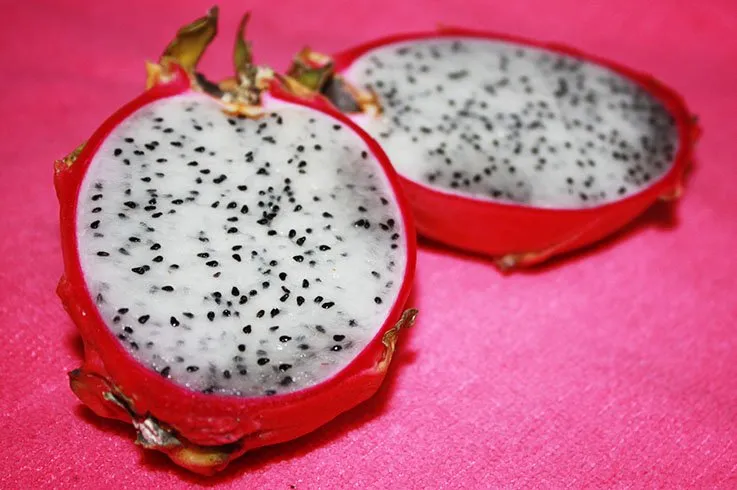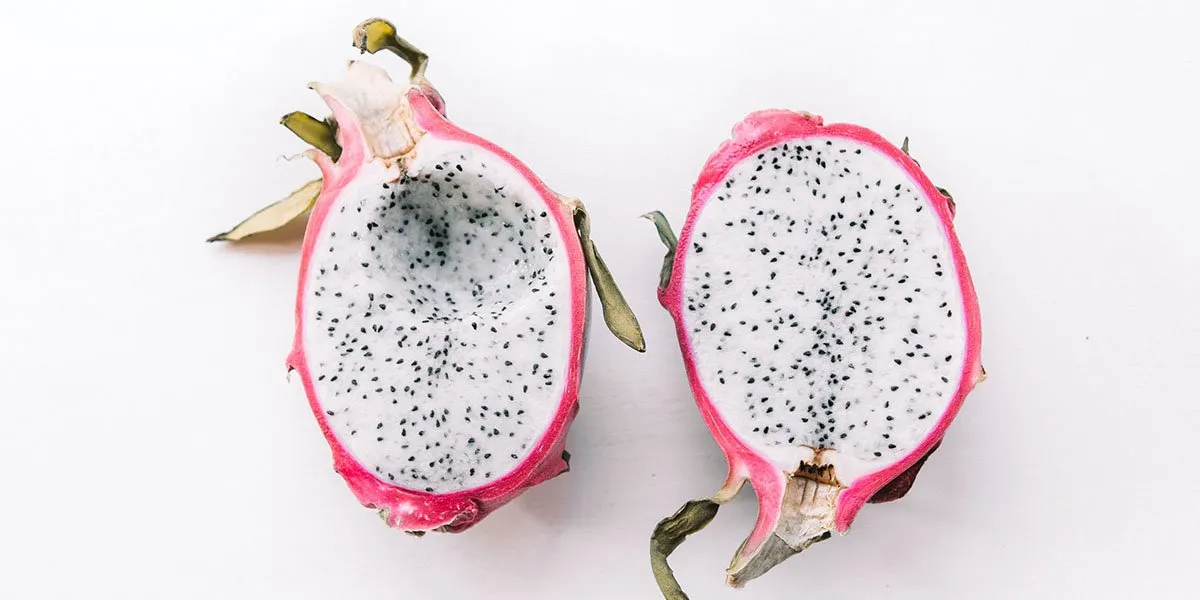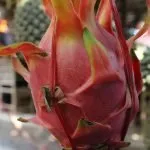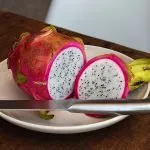Dragon fruit (or pitaya) will not stay ripe forever. After several days at room temperature or up to two weeks in the fridge, the tropical delicacy will no longer be edible.
The most important sign your dragon fruit has gone bad is the brown color of the flesh. Other indicators include a dry, shriveled stem and an excessively soft, mushy feeling when pressing the dragon fruit with your thumb.
Depending on the level of ripeness, different indicators will suggest the dragon fruit has gone bad. These can range from a strange color to obvious mold. The most important signs of ‘pitaya rot’ are discussed extensively in this overview.
1. Brown Color Starts To Appear
The otherwise white or pink flesh of old dragon fruit can quickly start to look darker and more brown. This doesn’t always mean the fruit has become inedible, if the rot is in early stages you could simply cut it away. If the rot has penetrated further, throw it away.
Cut pieces of dragon fruit will start to discolor the fastest, especially when kept outside of the fridge or freezer. An already cut fruit should be consumed as fast as possible. Already cut parts of fresh fruits are the most perishable of all.
Brown spots might also be present on unripe or exactly ripe dragon fruit. This is normal, and can simply be cut away. Only when the brown color starts emerging throughout the whole fruit, you will need to worry about the dragon fruit going bad.

2. Dragon Fruit Flesh Got Mushy
Another obvious sign of rotten dragon fruit is the firmness of the edible flesh. To assess the ripeness of an unopened fruit, firmly press your thumb on the skin. You will be able to feel how ripe the dragon fruit is:
- Unripe: Very firm, difficult to press on the skin and feel any movement
- Exactly ripe: Skin gives in a little bit from pressing it, still a bit firm
- Gone bad: Very soft skin, barely any firmness left in the fruit
Once opened, the consistency of the edible flesh will take away any doubt. If there is no firmness left and everything turned into slime, don’t hesitate to throw the fruit away immediately. If only part of the flesh turned very soft, check for other signs of rot to decide if parts are still edible.
3. Dry, Shriveled Fruit Stem
Now we get into the tricky part. A dry, shriveled stem is also present in a ready-to-eat fruit. However, that time window is relatively short, only a few days. After that, the dried-out stem will definitely be present in 100% of old pitayas.
Rotten fruit will have both a shriveled stem and mushy, brown flesh. So don’t use this indicator in isolation, but keep looking for other signs your dragon fruit went bad. It might still be edible.
If you’re unsure where the stem of the fruit is located — it’s found at the very top, right in the middle. If you cut the fruit in half, you can see how far down it goes and if it’s also shriveled there.
4. Withered Dry Leaves On Skin
Here’s another risky indicator — while 100% of old dragon fruit have shriveled dry leaves on the outside, so do most of the ready-to-eat fruits. So use this sign only in combination with other signs of rot. You don’t want to throw away perfectly edible food.
That being said, the otherwise green leaves of the dragon fruit will have shriveled up and become dry for ripe and overripe fruits. If this is the case, press your thumb into the skin to feel how ripe it really is.
Is the feeling too soft, the colors brown-ish, the flesh no longer firm, and the stem also shriveled up? Then you’d better throw the old fruit away. The image below shows a fruit starting to rot, but it might still be edible for the most part. If the decay went further than this, it is likely rotten.

5. Very Bland Kiwi-Like Taste
For those brave souls that dared to ignore all signs of rot, the extremely bland, but gross taste will be the last warning of rot. If you accidentally put some perished dragon fruit into your mouth, you will notice a distinct lack of flavor and firmness of the flesh.
Watery dragon fruit flesh that went bad reportedly faintly tastes like kiwi, but not in a good way. The slimy consistency of an old dragon fruit gives away that it has gone bad.
The absence of flavor might feel counter-intuitive, but that is the first stage of fruit rot for this tropical delicacy. If the rot and decay continue, mold and a terrible smell will slowly start to emerge over time.
6. Foul Smell Coming From Dragon Fruit
Fresh dragon fruit will smell fruity and floral, reminiscent of a mix between banana and kiwi. An old, rotten dragon fruit will be void of any smell at first, but slowly starts smelling acidic. The odor will remind you of the fruit rot in a kiwi.
The foul smell will only be present in severely rotten pitayas. It will generally barely smell like anything when the fruit is still edible.
Recently rotten dragon fruits will barely give off any odor at all. Once the dragon fruit has started giving off a terrible smell, the foul-smelling fruit has been rotten for many days. It is likely very obvious the fruit is rotten at that point. Mold will already be present.
7. Dragon Fruit Starts Showing Mold
The final stage of fruit rot in dragon fruits is mold growth. Blue or green moldy spots will slowly grow on the edible flesh, which will slowly spread. to the skin, stem, and leaves on the outside.
It is not common for a recently old dragon fruit to already show mold, it’s much more likely that it will show a brown color. The mold and foul smell are among the final stages of rot.
Do not confuse the black or brown spots in an otherwise perfectly edible pitaya with mold. That’s a bad spot, not mold. Dragon fruits that are moldy will no longer have any edible flesh left. You should worry about the brown colors and firmness of the flesh before any other rot signs.



